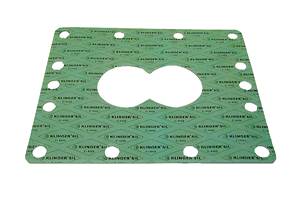K 2010 Preview, Compounding ‘Slower’ Compounders Suggest Trend Toward Energy-Efficient Designs
channel depth in larger machines, which exposes the material to less mechanical stress at comparable residence times.
channel depth in larger machines, which exposes the material to less mechanical stress at comparable residence times. Moreover, the combination of medium speeds and increased channel depths are said to substantially reduce screw and barrel wear. The company has optimized the extruder power train and heating system to further increase energy efficiency.
KM Berstorff also will introduce the EasyClean compounding line designed to reduce cleaning and changeover times by up to 40%. The design features clamp joints and clamped flange connections at the feed hoppers and the material conduits to the metering devices and the silos that can be loosened without tools.
The docking station for the bulk-solids metering device was also engineered to speed up product changeovers: During a change, the second metering device can be cleaned off-line.
The line at the show will be a ZZE 60-mm twin-screw equipped with a Mixomat—a device that combines conveying, weighing, and mixing functions in a single unit. This cost-effective system reduces the number of metering devices required for frequent compound changes involving different pellet types. A large cleaning opening allows quick cleanout when material or color is changed.
The Mini-Compounder KETSE 12/36, from Brabender (cwbrabender.com) is a 12-mm, 36:1 L/D twin-screw machine for product development and lab applications. The clamshell barrel opens to allow visual assessment of individual processing steps. Metering and venting ports can be located at 0 D, 6 D, 12 D and 26 D. Side feeding can be installed at 14 D. Brabender also offers this machine in a 20-mm, 40:1 L/D configuration.
HIGH-OUTPUT PELLETIZING
For high-capacity polyolefin production, Coperion (coperion.com) will display the UG 1.250, said to be the largest underwater pelletizer in the world. It enables throughputs in excess of 100 tons/hr for polyethylene. The first UG 1.250 will go into operation soon. A slightly smaller but similarly constructed UG 925 for polypropylene has been in operation since the middle of 2009.
Coperion is also offering an exceptionally large underwater pelletizer for TPE. The UG 750, which will be installed at the beginning of 2011, was designed to account for the stickiness typical of TPE pellets. Axial water flow along the knife shaft into the cutting chamber, and radial water flow along the pelletizing knives towards the water chamber exit, minimize turbulence in the cutting chamber. This results in fewer collisions between the freshly cut, tacky pellets, which prevents agglomeration.
Coperion will be introducing a new size melt pump. Model MP 450 can handle 30 to 50 tons/hr of PP and 40 to 50 tons/hr of PE. The pumps have single or twin shaft drive options.
Gala Industries (gala-industries.com) will show introduce its Model EAC (Electronically Adjusted) pelletizer for production rates up to 33,000 lb/hr. The pelletizer offers fully automated control of blade adjustment and positioning for maximum blade and die life. Monitoring and adjustment are programmed in the PLC controller. An integrated blade-position measuring system alerts the operator when a blade change is needed.Not too long ago, high-speed, high-torque twin-screw compounders were all the rage. They operated at blazing speeds up to 1800 rpm and required high drive power. At K 2010, KraussMaffei Berstorff (berstorff.com) is dialing back a bit, presenting a ZE 60 A UTX twin-screw with max. speed of 600 rpm and design features that enhance energy efficiency. KM Berstorff has conducted tests revealing that substantial energy savings and quality enhancements can be achieved in many applications if larger extruders are operated at medium speeds instead of using smaller machines at high speeds.
Related Content
10 Ways to Improve Twin-Screw Compounding Performance
There are many techniques known to operators and plant engineers for increasing the performance of a twin-screw compounding extruder.
Read MoreConfiguring the Twin Screw Extruder: Part 4
For many compounding operations, material is fed to the extruder at the feed throat. This is the case when feeding a single polymer or a blend of polymers mixed with solid additives. Some ingredients, however, present a challenge in feeding. Here’s how to solve to them.
Read MoreImproving Twin-Screw Compounding of Reinforced Polyolefins
Compounders face a number of processing challenges when incorporating a high loading of low-bulk-density mineral filler into polyolefins. Here are some possible solutions.
Read MoreProcessing Megatrends Drive New Product Developments at NPE2024
It’s all about sustainability and the circular economy, and it will be on display in Orlando across all the major processes. But there will be plenty to see in automation, AI and machine learning as well.
Read MoreRead Next
Advanced Recycling: Beyond Pyrolysis
Consumer-product brand owners increasingly see advanced chemical recycling as a necessary complement to mechanical recycling if they are to meet ambitious goals for a circular economy in the next decade. Dozens of technology providers are developing new technologies to overcome the limitations of existing pyrolysis methods and to commercialize various alternative approaches to chemical recycling of plastics.
Read MoreUnderstanding Melting in Single-Screw Extruders
You can better visualize the melting process by “flipping” the observation point so that the barrel appears to be turning clockwise around a stationary screw.
Read MoreHow Polymer Melts in Single-Screw Extruders
Understanding how polymer melts in a single-screw extruder could help you optimize your screw design to eliminate defect-causing solid polymer fragments.
Read More


























